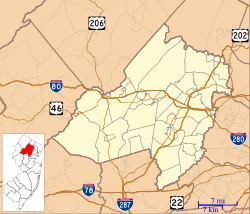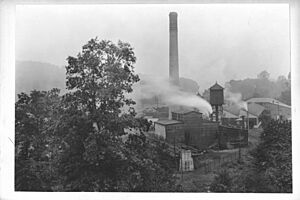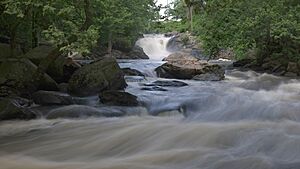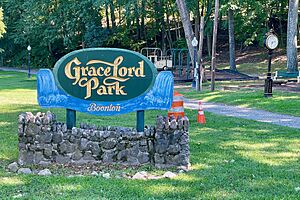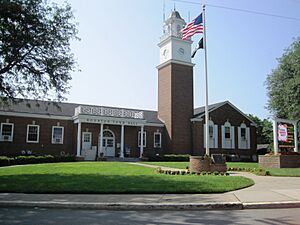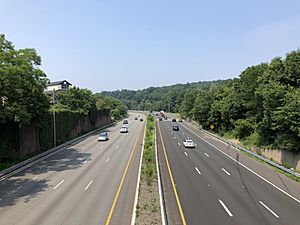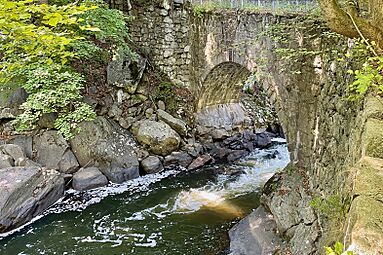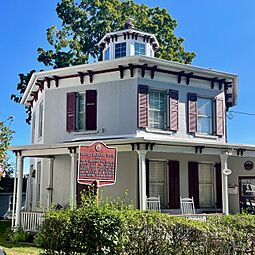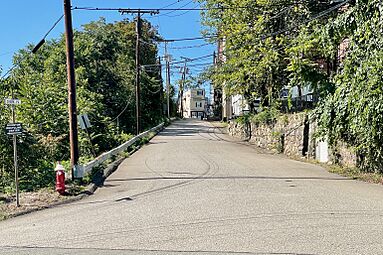Boonton, New Jersey facts for kids
Quick facts for kids
Boonton, New Jersey
|
||
|---|---|---|
|
Town
|
||

Boonton Public Library, listed on the NRHP
|
||
|
||
| Motto(s):
A Great Place to Live and Work
|
||
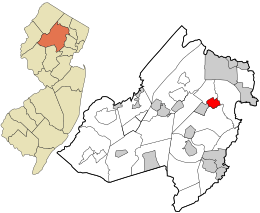
Location of Boonton in Morris County highlighted in red (right). Inset map: Location of Morris County in New Jersey highlighted in orange (left).
|
||
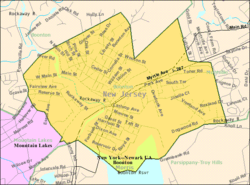
Census Bureau map of Boonton, New Jersey
|
||
| Country | ||
| State | ||
| County | Morris | |
| Formed | March 16, 1866 | |
| Reincorporated | March 18, 1867 | |
| Named for | Thomas Boone | |
| Government | ||
| • Type | Town | |
| • Body | Town Council | |
| Area | ||
| • Total | 2.49 sq mi (6.44 km2) | |
| • Land | 2.34 sq mi (6.07 km2) | |
| • Water | 0.14 sq mi (0.38 km2) 6.39% | |
| Area rank | 374th of 565 in state 31st of 39 in county |
|
| Elevation | 397 ft (121 m) | |
| Population
(2020)
|
||
| • Total | 8,815 | |
| • Estimate
(2024)
|
8,894 | |
| • Rank | 269th of 565 in state 22nd of 39 in county |
|
| • Density | 3,775.2/sq mi (1,457.6/km2) | |
| • Density rank | 174th of 565 in state 8th of 39 in county |
|
| Time zone | UTC−05:00 (Eastern (EST)) | |
| • Summer (DST) | UTC−04:00 (Eastern (EDT)) | |
| ZIP Code |
07005
|
|
| Area code(s) | 973 | |
| FIPS code | 3402706610 | |
| GNIS feature ID | 0885164 | |
Boonton (pronounced 'BOO-tuhn') is a town in Morris County, New Jersey. In 2020, about 8,815 people lived there. The town's name comes from "Boone-Towne," given in 1761 to honor Colonial Governor Thomas Boone.
Boonton officially became a town on March 16, 1866. It was reincorporated and became fully independent on March 18, 1867.
The town started growing around 1829. This happened because the Morris Canal was being built, and the New Jersey Iron Company was formed. The original town site is now mostly covered by the Jersey City Reservoir, which was finished in 1904. In 1908, the water from this reservoir was the first public water supply in the United States to be treated with chlorine. This helped make the water safe to drink.
Contents
History of Boonton
During the 1700s, a settlement called Booneton Falls began along the Rockaway River. It was about 1.5 miles downstream from where Boonton is today. In 1747, a man named Obadiah Baldwin started an iron refining forge there. He used local iron ore, charcoal, and water power from the river. As the ironworks grew, a community formed in 1761. They named it "Boone-Towne" after Governor Thomas Boone.
The current town of Boonton grew separately from Booneton Falls. After 1830, the Morris Canal was completed, which changed trade routes. This caused people to move away from the old Booneton Falls site. Since 1903, the original site of Old Boonton has been covered by the Jersey City reservoir.
Boonton's Iron Industry
The Boonton Iron Works started around 1770. Samuel Ogden bought land along the Rockaway River to build it. During the American Revolutionary War, the Iron Works made many iron products for the military. After the war, others continued to run the ironworks.
In 1824, William Scott, who was trying to improve the ironworks, learned that the Morris Canal would bypass Booneton. However, the canal's closeness to Booneton Falls made it a great spot for a new factory. In 1830, a group of New York City businessmen started the New Jersey Iron Company. They brought machinery and ironworkers from England. A new community, also called Booneton Falls, grew around these new mills.
The main street of this new community is unique. It is built on a cliff overlooking the "Hollow" of the Rockaway River. People say it followed an old Native American trail.
The new Iron Company did well for almost 50 years. But like the older Booneton, this new settlement depended on one industry. When the Company closed in 1876, the town faced hard times. Even though some tried to restart ironworks on a smaller scale, they didn't last long. Today, you can still see parts of old foundations in the "Hollow." These remind Boonton of its past as an iron-making town.
Other Important Industries
After the ironworks closed, Boonton attracted new businesses. One of the first was a silk factory, which later became Van Raalte, Inc. Other factories followed, including a knife factory, a paper mill, a nail factory, and a carriage factory. Even though railroads were becoming more popular, the Morris Canal still provided some jobs. The Lackawanna Railroad finished its Boonton Branch in 1870. This gave jobs to many Boonton residents and allowed people to commute to New York City for work.
In 1891, the Loanda Hard Rubber Company started making molded hard rubber products. Richard W. Seabury, who managed the company later, learned about new synthetic resins from Leo Baekeland. In 1907, Seabury used this new material to create the world's first molded organic plastics. This led to "Boontonware," a popular plastic dinnerware sold across the country.
George Scribner, the son of Loanda's founder, continued the plastics business by starting Boonton Molding. They made Boontonware dinnerware in the 1950s and 1960s. George Scribner was even inducted into the Plastics Hall of Fame for his work in developing molding techniques.
The plastics industry also attracted radio and electronics companies to Boonton. In the 1920s, the growing radio industry needed many molded parts. Richard W. Seabury started Radio Frequency Laboratories to work in this new field. Many other electronics companies grew from this, becoming known worldwide for their products. For example, Boonton Radio Co. made a high-quality test instrument called a Q meter. Many of these companies have since been bought by larger corporations and moved.
In 1917, E.A. Stevenson & Company opened the "Butter Works." They processed coconut and other vegetable oils to make margarine. Later, under E.F. Drew & Company, this plant became one of the largest edible oil processors in the country. It was Boonton's biggest industry in the 1900s. The plant closed in the early 1990s, and a Walmart store was built on the site.
Today, Boonton has become a center for art. Several art galleries are located on Main Street, forming what is called the Boonton Art District. These galleries often hold special art walks on the first Friday of each month.
Boonton's Geography
Boonton covers about 2.49 square miles (6.46 square kilometers). Most of this is land, with a small amount of water.
The Rockaway River flows through the Boonton Gorge downtown. It has exciting whitewater rapids and a waterfall that is 25 feet high.
Boonton shares borders with other towns in Morris County. These include Boonton Township, Montville, Mountain Lakes, and Parsippany-Troy Hills.
Boonton's Climate
| Climate data for Boonton 1 SE, New Jersey (1991–2020 normals, extremes 1893–present) | |||||||||||||
|---|---|---|---|---|---|---|---|---|---|---|---|---|---|
| Month | Jan | Feb | Mar | Apr | May | Jun | Jul | Aug | Sep | Oct | Nov | Dec | Year |
| Record high °F (°C) | 71 (22) |
75 (24) |
83 (28) |
93 (34) |
98 (37) |
99 (37) |
102 (39) |
103 (39) |
104 (40) |
90 (32) |
80 (27) |
77 (25) |
104 (40) |
| Mean daily maximum °F (°C) | 37.6 (3.1) |
40.0 (4.4) |
48.4 (9.1) |
61.1 (16.2) |
71.0 (21.7) |
80.7 (27.1) |
85.4 (29.7) |
83.6 (28.7) |
76.5 (24.7) |
64.1 (17.8) |
52.6 (11.4) |
42.4 (5.8) |
62.0 (16.7) |
| Daily mean °F (°C) | 29.1 (−1.6) |
30.9 (−0.6) |
38.5 (3.6) |
50.1 (10.1) |
60.1 (15.6) |
69.7 (20.9) |
74.7 (23.7) |
72.8 (22.7) |
65.5 (18.6) |
53.2 (11.8) |
42.8 (6.0) |
34.3 (1.3) |
51.8 (11.0) |
| Mean daily minimum °F (°C) | 20.6 (−6.3) |
21.8 (−5.7) |
28.7 (−1.8) |
39.1 (3.9) |
49.3 (9.6) |
58.8 (14.9) |
64.0 (17.8) |
62.1 (16.7) |
54.4 (12.4) |
42.4 (5.8) |
33.1 (0.6) |
26.2 (−3.2) |
41.7 (5.4) |
| Record low °F (°C) | −15 (−26) |
−20 (−29) |
−3 (−19) |
8 (−13) |
26 (−3) |
32 (0) |
42 (6) |
36 (2) |
29 (−2) |
16 (−9) |
6 (−14) |
−21 (−29) |
−21 (−29) |
| Average precipitation inches (mm) | 3.73 (95) |
2.79 (71) |
4.16 (106) |
3.63 (92) |
3.95 (100) |
4.91 (125) |
4.70 (119) |
3.67 (93) |
4.68 (119) |
4.54 (115) |
4.06 (103) |
4.36 (111) |
49.18 (1,249) |
| Average precipitation days (≥ 0.01 in) | 10.5 | 10.0 | 11.0 | 12.2 | 13.4 | 12.1 | 10.9 | 10.2 | 9.2 | 11.2 | 8.1 | 12.1 | 130.9 |
| Source: NOAA | |||||||||||||
Population and People
| Historical population | |||
|---|---|---|---|
| Census | Pop. | %± | |
| 1870 | 3,458 | — | |
| 1880 | 2,277 | −34.2% | |
| 1890 | 2,981 | 30.9% | |
| 1900 | 3,901 | 30.9% | |
| 1910 | 4,930 | 26.4% | |
| 1920 | 5,372 | 9.0% | |
| 1930 | 6,866 | 27.8% | |
| 1940 | 6,739 | −1.8% | |
| 1950 | 7,163 | 6.3% | |
| 1960 | 7,981 | 11.4% | |
| 1970 | 9,261 | 16.0% | |
| 1980 | 8,620 | −6.9% | |
| 1990 | 8,343 | −3.2% | |
| 2000 | 8,496 | 1.8% | |
| 2010 | 8,347 | −1.8% | |
| 2020 | 8,815 | 5.6% | |
| 2024 (est.) | 8,894 | 6.6% | |
| Population sources: 1870–1920 1870 1880–1890 1890–1910 1910–1930 1940–2000 2000 2010 2020 |
|||
How Many People Live Here?
In 2010, the 2010 United States census counted 8,347 people living in Boonton. There were 3,235 households, and 2,112 families. The town had about 3,575 people per square mile.
About 78.8% of the people were White, 4.8% Black or African American, and 10.1% Asian. About 11% of the population identified as Hispanic or Latino.
About 29% of households had children under 18. The average household had 2.54 people, and the average family had 3.10 people. The median age in Boonton was 39.4 years old.
Income and Diversity
In 2010, the average household income was about $79,097. The average family income was about $89,965. About 10.7% of the population lived below the poverty line.
In 2000, Boonton had a notable percentage of people with Pakistani ancestry (3.53%). It also had a high percentage of people with Turkish American ancestry (1.3%).
Sports and Recreation
North Stars Gymnastics Academy is a gymnastics center in Boonton. It is home to many talented gymnasts.
Grace Lord Park offers fun activities and hiking trails. You can also see the beautiful Boonton Falls from the park.
Boonton's Government
How Boonton is Governed
Boonton has a "town" form of government. This means it is run by a Mayor and a Town Council. The governing body used to be called the Board of Aldermen. In February 2021, they voted to change the name to Town Council. This was done to be more inclusive and encourage more women to run for office.
The Mayor is elected by all voters in the town for a four-year term. The Town Council has eight members. Two Council Members are elected from each of the four wards (sections of the town). They serve two-year terms, with one seat from each ward up for election every year.
As of 2025, the Mayor of Boonton is Republican James Lynch. His term ends on December 31, 2027. The current members of the Town Council are:
- Council President John Meehan (Ward 1; Republican, 2025)
- Daniel Ballan (Ward 3; Republican, 2026)
- Marie DeVenezia (Ward 2; Democrat, 2026)
- Jacob W. Hettrich (Ward 2; Democrat, 2025)
- Alexis Minson (Ward 4; Republican, 2025)
- Robert Murray (Ward 3; Republican, 2025)
- Benjamin Weisman (Ward 4; Democrat, 2026)
- Cy Wekilsky (Ward 1; Republican, 2026)
Representation in Government
Boonton Town is part of the 11th Congressional District for national elections. For state elections, it is in New Jersey's 26th legislative district.
New Jersey's Eleventh Congressional District is represented by Rodney Frelinghuysen (R, Harding Township). New Jersey is represented in the United States Senate by Cory Booker (D, Newark, term ends 2021) and Bob Menendez (D, Paramus, 2019). For the 2016–2017 session (Senate, General Assembly), the 26th Legislative District of the New Jersey Legislature is represented in the State Senate by Joseph Pennacchio (R, Montville) and in the General Assembly by BettyLou DeCroce (R, Parsippany-Troy Hills) and Jay Webber (R, Morris Plains). Morris County is governed by a Board of County Commissioners composed of seven members who are elected at-large in partisan elections to three-year terms on a staggered basis, with either one or three seats up for election each year as part of the November general election. Actual day-to-day operation of departments is supervised by County Administrator Deena Leary. As of 2024[update], Morris County's Commissioners are:
John Krickus (R, Chatham Township, 2024), Director Christine Myers (R, Harding, 2025), Douglas Cabana (R, Boonton Township, 2025), Thomas J. Mastrangelo (R, Montville, 2025), Deputy Director Stephen H. Shaw (R, Mountain Lakes, 2024), Deborah Smith (R, Denville, 2024) and Tayfun Selen (R, Chatham Township, 2026)
The county's constitutional officers are: Clerk Ann F. Grossi (R, Parsippany–Troy Hills, 2028), Sheriff James M. Gannon (R, Boonton Township, 2025) and Surrogate Heather Darling (R, Roxbury, 2024).
Voting in Boonton
As of March 23, 2011, there were 5,037 registered voters in Boonton. About 20.4% were registered as Democrats, 38.8% as Republicans, and 40.7% were not affiliated with any party.
In the 2012 presidential election, Barack Obama (Democrat) received 51.6% of the votes. Mitt Romney (Republican) received 47.2%. In the 2013 governor's election, Chris Christie (Republican) received 67.2% of the votes. Barbara Buono (Democrat) received 30.3%.
Education in Boonton
The Boonton Public Schools serve students from kindergarten through twelfth grade. In the 2020–21 school year, the district had 1,457 students and 132.8 teachers. This means there were about 11 students for every teacher.
The schools in the district are:
- School Street School (Pre-K–2)
- John Hill School (grades 3–8)
- Boonton High School (grades 9–12)
Boonton High School also serves students from Lincoln Park. These students attend Boonton High School as part of a special agreement.
Our Lady of Mount Carmel School is a Catholic school for students from preschool to eighth grade. It has been open since 1882 and is part of the Roman Catholic Diocese of Paterson.
Transportation in Boonton
Roads and Highways
As of 2015, Boonton had about 33.90 miles of roads. Most of these roads are maintained by the town itself. Major highways like Interstate 287 and U.S. Route 202 pass through Boonton.
Public Transportation
The Boonton station offers train service on the NJ Transit Montclair-Boonton Line. You can take trains to places like Newark Broad Street Station, Penn Station New York, and Hoboken Terminal.
NJ Transit also provides local bus service on the 871 route. Lakeland Bus Lines offers express bus service along Route 46, connecting Boonton to Midtown Manhattan.
Places to Visit
- Arch Bridge from the Boonton Ironworks – This old stone arch bridge was built in 1866. It's important for its engineering and is listed on the National Register of Historic Places. You can find this footbridge, which crosses the Rockaway River, in Grace Lord Park.
- Garret Rickards House – This is one of two unique octagon houses on Cornelia Street. They are part of the Boonton Historic District.
- Morris Canal Greenway – This trail follows the path of the old Morris Canal. The Boonton section starts in Grace Lord Park. Plane Street is where Inclined Plane 7 East of the canal used to be.
- Greenwood Cemetery
-
Plane Street – Site of Inclined Plane 7 East of the Morris Canal
Boonton Holmes Public Library
The Boonton Holmes Public Library has been open since 1894. The building was given to the town by James Holmes to be used as a public library. James Holmes moved to Boonton in 1850. He was a very important person in the town, serving as Mayor and on the State Board of Education. He used his wealth to help improve Boonton, like donating land for a firehouse. He also started the first Boonton National Bank.
The library building itself is much older. It was first built in 1849. James Holmes bought the property in 1856 and lived there until he passed away in 1893. He left his house and money to the Boonton Library Association. The library officially opened in 1894.
Originally, only the first floor and basement were used for the library. The upper floors were used for businesses or apartments. The basement even housed the printing press for The Boonton Times newspaper for a while.
The Boonton Holmes Public Library building was added to the National Register of Historic Places on November 30, 1972.
Famous People from Boonton
Many interesting people have lived in or are connected to Boonton:
- Othmar Ammann (1879–1965), a structural engineer who designed famous bridges like the George Washington Bridge.
- Angelo Badalamenti (1937-2022), a composer known for his film music.
- Amanda Bennett (born 1952), a Pulitzer Prize-winning journalist.
- Anthony M. Bucco (born 1962) and Anthony R. Bucco (1938–2019), a father and son who both served in the New Jersey Senate.
- Helen Gahagan Douglas (1900–1980), an actress and politician.
- Dean Gallo (1935–1994), a politician who represented New Jersey in Congress.
- John Hill (1821–1884), who represented New Jersey in Congress.
- Peter Onorati (born 1954), an actor.
See also
 In Spanish: Boonton para niños
In Spanish: Boonton para niños



